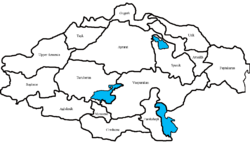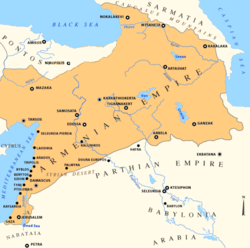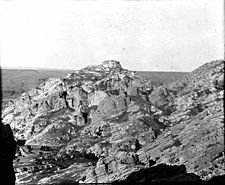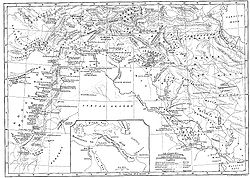- Corduene
-
Կորճայք Province of Greater Armenia 189 BC–1th century AD Capital Pinik History - Artaxias I declaring himself independent 189 BC - Conqered by Seljuk Turks[1] 1th century AD This article is part of the
Kurdish history and Culture seriesAncient history - Corduene
- Kayusid
Medieval history Modern history Culture - Kurdish language
- Kurdish Literature
- Kurdish Music
- Kurdish Dance
- Historical sites
Corduene (Armenian: Կորճայք, also known as Gorduene, Cordyene, Cardyene, Carduene, Gordyene, Gordyaea, Korduene, Korchayk, Gordian, Hebrew:[2]קרטיגיני ) was an ancient region located in northern Mesopotamia and modern day Kurdish inhabited south east Turkey. It was a province of the Greater Armenia. It was referred to by the Greeks as Karduchia and by both the Greeks and Romans as Corduene. .
Corduene's territory was 14,707 km2 (6,000 sq mi) and had 11 cantons:
- Korduq (or Korduk)
- Kordiq Nerkin or Tmoriq
- Kordiq Verin
- Kordiq Mijin
- Tshauk
- Aitvanq
- Vorsirank (or Orsirank)
- Aigarq
- Motolanq
- Kartuniq
- Albag.[1]
History
From 800s to 595 BC it was part of Urartu. From 595 BC it was part of Armenian Orontid Dynasty, which was soon conquered by Achaemenid Empire and was created Satrapy of Armenia. After 331 BC it became independent. In 201 BC two Armenian commanders of Seleucid Empire army, Artaxias and Zareh conquered Armenia' From 189 BC, when Artaxias I declared himself independent, Corduene was part of Kingdom of Armenia until 387's division. It was again reunited with Armenia, from IX-XI under Vaspurakan Kingdom.
According to the 1911 Encyclopaedia Britannica, Gordyene is the ancient name of the region of Bohtan (now Şırnak Province).[3] It is mentioned as Beth Qardu in Syriac sources and is described as a small vassal state between Armenia and Persia in the mountainous area south of Lake Van in modern Turkey[4] Corduene must also be sought on the left bank of the Tigris.
It has been cited as the country of the Carduchians, a fertile mountainous district, rich in pasturage.[5] The three principalities of Corduene, Moxoene, and Zabdicene are referred to as Carduchian dynasties by Toumanoff.[6] The Kingdom of Gordyene emerged from the declining Seleucid Empire and for most of its history, it was a province of the Roman Empire[7] and acknowledged the sovereignty of Rome.[8] From 189 to 90 BC it enjoyed a period of independence.
The people of Gorduene were known to have worshipped the Hurrian sky God Teshub.[9]
Origins
According to Arshak Safrastian, the Medes and Scythians mentioned in classical Greek literature existed only as preconceived notions. Equating the Carduchi with the Gutians, he adds that the moment the Ten Thousand began to skirt the lower slopes of the Hamrin Mountains, they were in contact with the tribes of Gutium which are presented here as Medes or Scythians.[10]
Carduchoi in Xenophon
A people called the Carduchoi are mentioned in Xenophon's Anabasis. They inhabited the mountains north of the Tigris in 401 BC, living in well-provisioned villages. They were enemies to the king (of Persia), as were the Greek mercenaries with Xenophon, but their response to thousands of armed and desperate strangers was hostile. They had no heavy troops who could face the battle-hardened hoplites, but they used longbows and slings effectively, and for the Greeks the "seven days spent in traversing the country of the Carduchians had been one long continuous battle, which had cost them more suffering than the whole of their troubles at the hands of the king and Tissaphernes put together."[11]
They have been also mentioned as Gordi by Hecataeus of Miletus ca 520 BC.
Corduene in Jewish Sources
Targum, a Jewish source of Talmudic period, consistently understands Ararat to be located in Gorduene and not in Armenia.[12] This region is usually identified with the landing site in Deluge mythology. According to Aggadah, Noah landed in Korduene in Armenia. Berossus was also of the opinion that Xisthros landed with his ship in Korduene.[13] Josephus cited the evidence of Berossus as proof that the Flood was not a myth and also mentioned that the remains of the Ark were still visible in the district of Carron, persumably identical with Korduene.[14] In Nashim, the third order of Talmud, Rav Nahman bar Jacob has allowed proselytization of Kurds from Corduene.[15] This points to the existence of Jewish converts among the population of Corduene in the early 4th century.
Corduene in Roman Sources
According to the Roman historian Strabo, the region of Gorduene (Γορδυηνῆ, or Γoρδυαῖα ὄρη, "Gordyaean Mts") referred to the mountains between Diyarbakır and Muş.[16][17] He recorded its main cities as Sareisa, Satalca and Pinaca (northwest of Bezabde), and considered its inhabitants (Gordyaeans) as descendants of the ancient Carduchians. According to him, the inhabitants had an exceptional repute as master-builders and as experts in the construction of siege engines and for this reason Tigranes used them in such work; he also notices the country for its naphtha resources.[18] Ammianus Marcellinus visited this region while on a diplomatic visit to the satrap of Corduene.[19] Eretrians who were exiled and deported by the Persians to Mesopotamia, were said to have taken up their dwelling in the region of Gordyene.[20]
According to Strabo the Gordyaeans received their name from Gordys son of Triptolemus, who assisted in searching after Io, and then settled in Gordyaea district of Phrygia.[21]
Pompey and Corduene
Both Phraates III and Tigranes the Great laid claim to this province. However, it was conquered by the Roman troops under Pompey. The local population (called Gordyeni) did not defend the Armenian rule since according to Plutarch, Tigranes had demolished their native cities and had forced them into exile in Tigranocerta.[22] In 69 BC, Zarbienus, the king of Corduene, was secretly planning for a revolt against Tigranes. He was negotiating with Appius Claudius for Roman help. However the plan was revealed and he was killed by Tigranes. After this, Lucullus raised a monument to Zarbienus and then he took over the region of Corduene.[23] He took part in the funeral of Zarbienus, offered royal robes, gold and the spoils (taken from Tigranes), and called him his companion and confederate of the Romans.[24]
After Pompey's success in subjugating Armenia and part of Pontus, and the Roman advance across the Euphrates, Phraates was anxious to have a truce with the Romans. However, Pompey held him in contempt and demanded back the territory of Corduene. He sent envoys, but after receiving no answer, he sent Afranius into the territory and occupied it without a battle. The Parthians who were found in possession were driven beyond the frontier and pursued even as far as Arbela[disambiguation needed] in Adiabene.[25] According to an inscription dedicated to the temple of Venus, Pompey gave protection to the newly acquired territory of Gordyene.[26]
Diocletian and Corduene
Corduene was conquered again by Diocletian in the 3rd century and the Roman presence in the region was formally recognized in a peace treaty signed between Diocletian and the Persians. Diocletian then raised an army unit from this region under the title Ala XV Flavia Carduenorum, naming it after his Caesar Flavius Valerius Constantinus.[27]
Following the defeat of Narseh, the Sassanid King, at the hands of the Romans in 296, a peace treaty was signed between the two sides, according to which the steppes of northern Mesopotamia, with Singara and the hill country on the left bank of the Tigris as far as Gordyene (Corduene), were also ceded to the victors (Romans).[28]
The name of the province appears again in the account of the campaign between the Persians led by Shapur II and the Romans led by Julian the Apostate (and after Julian's death, by Jovian). The Romans started to retreat through Corduene after they could not besiege Ctesiphon.[29]
Shapur's campaign against Corduene
In the spring of 360, Shapur II staged a campaign to capture the city of Singara (probably modern Shingar or Sinjar northwest of Mosul). The town fell after a few days of siege. From Singara, Shapur directed his march almost due northwards, and leaving Nisibis unassailed upon his left, proceeded to attack the strong fort known indifferently as Pinaca (Phaenicha) or Bezabde. This was a position on the east bank of the Tigris, near the point where that river quits the mountains and debouches upon the plain; though not on the site, it may be considered the representative of the modern Jezireh (Cizre in southeastern Turkey), which commands the passes from the low country into the Kurdish mountains. It was much valued by Rome, was fortified in places with a double wall, and was guarded by three legions and a large body of Kurdish archers. Shapur sent a flag of truce to demand a surrender, joining with the messengers some prisoners of high rank taken at Singara, lest the enemy should open fire upon his envoys. The device was successful; but the garrison proved staunch, and determined on resisting to the last. After a long siege, the wall was at last breached, the city taken, and its defenders indiscriminately massacred.[30]
In 363, a treaty was signed in which Jovian ceded five provinces beyond the Euphrates including Corduene and Arzanene and towns of Nisibis and Singara to the Sassanids. Following this treaty, Greeks living in those lands emigrated due to persecution of Christians at the hands of Shapur and the Zoroastrians.[31]
Corduene was a bishop's see since at least 424.[32]
Corduene in the sixth and seventh centuries
In 578, the Byzantine emperor Flavius Mauricius Tiberius Augustus defeated the Sassanid army led by Chosroes I, and conquered Carduene and incorporated it once again in the Roman empire. The Roman army also liberated 10,000 Christian captives of the Sassanids.[33] According to Khwarizmi, Arabs conquered the area along with Nisbis and Tur Abdin in 640.[34]
List of kings
- Zarbienus; early-mid 1st c. BC: A famous king of Cordyene, made overtures to Appius Claudius, when the latter was staying at Antiocheia, wishing to shake off the yoke of Tigranes. He was informed against, however, and was assassinated with his wife and children before the Romans entered Armenia. When Lucullus arrived he celebrated his funeral rites with great pomp, setting fire to the funeral pile with his own hand, and had a sumptuous monument erected to him.
- King Manisarus; ~ 115 AD He took control over parts of Armenia and Mesopotamia, in the time of Trajan; therefor Osroes, the Parthian king, declared war against him; Manisarus sided with Romans. There are some coins extant, which are assigned to Manisarus.
- Ardashir; ~ 340s AD He was against christianization of Corduene.[35]
- Jovinian ~ 359 AD [36]
Corduene, Carduchi, and the Kurds
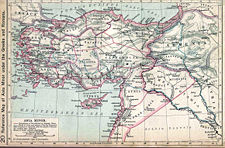 Map showing kingdoms of Corduene and Adiabene in the first centuries BC. The blue line shows the expedition and then retreat of the ten thousand through Corduene in 401 BC.
Map showing kingdoms of Corduene and Adiabene in the first centuries BC. The blue line shows the expedition and then retreat of the ten thousand through Corduene in 401 BC.
Some 19th-century scholars, such as George Rawlinson, identified Corduene and Carduchi with the modern Kurds, suggesting that Carduchi was the ancient lexical equivalent of "Kurdistan".[37][38][39]
Some recent academic sources disagree, suggesting that Corduene should be described as proto-Kurdish.[40]
There were numerous forms of this name, partly due to the difficulty of representing kh in Latin. The spelling Karduchoi is itself probably borrowed from Armenian, since the termination -choi represents the Armenian language plural suffix -kh.[41] It is speculated that Carduchi spoke an Old Iranic language[42]
Timeline of the history of Corduene (Gordyene)
- To Urartu 800s-595 BC
- To Satrapy of Armenia 595-201 BC
- To the Seleucid Empire 201-189 BC
- To Kingdom of Armenia (antiquity) 189 BC-428 AD [1]
- To Persia 428-653
- To Arab Caliphate 653-885
- To Vaspurakan Kingdom 885-1021
- To Byzantine Empire 1021-1071
- To Seljuk Turks 1071-XIII
- To Mongol Empire XIII-XV
- To the Ottoman Empire XV-1923
- To Turkey 1923
Notes
- ^ a b c Armenian Soviet Encyclopedia, 5th volume, pages 658-659
- ^ Efraim Elimelech Urbach, I. Abrahams, The Sages, 1089 pp., Magnes Press, 1979, ISBN 965-223-319-6, p.552
- ^ DARIUS III - DARIUS III, from 1911 Encyclopedia Britanica.
- ^ Parthian City Index
- ^ Persia - LoveToKnow 1911
- ^ C. Toumanoff, Introduction to Christian Caucasian History II: Status and Dynasties of the Formative Period, Traditio, Vol. XVII, pp.1-107, 1961, Frodham University Press, New York. (see pp.31-32)
- ^ Theodor Mommsen History of Rome - The Establishment of the Military Monarchy Page 24
- ^ The History of the Decline and Fall of The Roman Empire - Vol 2 - Chapter XXIV Part IV
- ^ Olaf A. Toffteen, Notes on Assyrian and Babylonian Geography, The American Journal of Semitic Languages and Literatures, pp.323-357, 1907, p.341
- ^ A. Safrastian, Kurds and Kurdistan, The Harvill Press, 1948, p. 29
- ^ Anabasis by Xenophon, book 4
- ^ Jacob Neusner, The Jews in Pagan Armenia, Journal of the American Oriental Society, pp.230-240, 1964, p.233
- ^ Bernhard Heller, Ginzberg's Legends of the Jews, The Jewish Quarterly Review, pp.51-66, Center for Advanced Judaic Studies, University of Pennsylvania, 1933, p.57
- ^ Louis H. Feldman, Josephus' Portrait of Noah and Its Parallels in Philo, Pseudo-Philo's Biblical Antiquities and Rabbinic Midrashim, Proceedings of the American Academy for Jewish Research, pp.31-57, 1988, p.47
- ^ Heinrich Walter Guggenheimer, The Jerusalem Talmud, Halakhah 6, 2004, ISBN 3-11-018291-2 ,pp.62-63
- ^ Strabon Book 11
- ^ Kurds & Kurdistan, Encyclopaedia of Islam.
- ^ LacusCurtius • Strabo's Geography — Book XVI Chapter 1
- ^ Ronald Syrme, Anatolica: Studies in Strabo, Oxford University Press, 1995, ISBN 0-19-814943-3, p.30
- ^ Strabo, Geography, Book XVI, Chapter 1, p.233-235 [1]
- ^ GORDYS, Greek Mythology Index
- ^ The Life of Lucullus, in The Parallel Lives by Plutarch.
- ^ T. Frank, Two Suggestions on the Text of Cicero, The American Journal of Philology, pp.459-461, 1937.
- ^ Lives, Chapter 36, Plutarch.
- ^ Cassius Dio — Book 37
- ^ G. Gilbert, The List of Names in Acts 2: Roman Propaganda and the Lukan Response, Journal of Biblical Literature, Vol.121, No.3, Autumn 2002, p.514.
- ^ E.C. Nischer, The Army Reforms of Diocletian and Constantine and Their Modifications up to the Time of the Notitia Dignitatum, The Journal of Roman Studies, pp.1-55, 1923. (see p.10)
- ^ Narses - Britannica Online Encyclopedia
- ^ Structure of the Res Gestae - The Ammianus Marcellinus Online Project
- ^ The Seven Great Monarchies, by George Rawlinson, The Seventh Monarchy, Part A
- ^ J. B. Bury, History of the Later Roman Empire from Arcadius to Irene (395 A.D. -800 A.D.), Adamant Media Corp., 2005, ISBN 1-4021-8369-0, p.304
- ^ The Acts of Mar Mari the Apostle, page 15, Amir Harrak, Published 2005 BRILL, 110 pages, ISBN 90-04-13050-0
- ^ George Frederick Young,East and West through fifteen centuries : being a general history from B.C. 44 to A.D. 1453, Vol.II, 674 pp., Longman, Green and Co. Publishers, 1916, p.336
- ^ A. N. Palmer, Monk and Mason on the Tigris Frontier: The Early History of Tur Abdin, Cambridge University Press, 1990, ISBN 0-521-36026-9, p.158
- ^ History of the Syrian Nation and the Old Evangelical-Apostolic Church of the East, page: 128, George David Malech, Published 2006, Gorgias Press LLC, 484 pages, ISBN 1-59333-408-7
- ^ The Later Roman Empire: AD 354-378, Ammianus Marcellinus, Translated by Walter Hamilton, page 155, Contributor Andrew Wallace-Hadrill, Published 1986, Penguin Classics, ISBN 0-14-044406-8
- ^ Rawlinson, George, The Seven Great Monarchies Of The Ancient Eastern World, Vol 7, 1871. (copy at Project Gutenberg)
- ^ Orbis Latinus, University of Columbia.
- ^ Kurds. The Columbia Encyclopedia, Sixth Edition. 2001-07
- ^ Revue des études arméniennes, vol.21, 1988-1989, p.281, By Société des études armeniennes, Fundação Calouste Gulbenkian, Published by Imprimerie nationale, P. Geuthner, 1989.
- ^ M.Th. Houtsma, E.J. Brill's first encyclopaedia of Islam, 1913-1936, ISBN 90-04-08265-4, see p.1133
- ^ [2] ref>M. Chahin, Before the Greeks, p. 109, James Clarke & Co., 1996, ISBN 0-7188-2950-6
External links
- Corduene or Gordyene, Classical Dictionary of Biography, Mythology and Geography.
- Geography, Strabo, Book XVI, Chapter 1, Section 24.
- Kurds and Kurdistan, see section iii History, subsection A Origins and Pre-Islamic History, Encyclopaedia of Islam.
- Map of Corduene
- Map of Gordyene between Assyria and Lake Van
- Theodor Mommsen History of Rome, The Establishment of the Military Monarchy, Page 53
- Decline and Fall of the Roman Empire
- Roman History, by Cassius Dio, Book XXX
- The History of the Decline and Fall of the Roman Empire, Vol. 2, Chapter XXIV, Part IV, The Retreat and Death of Julian], by Edward Gibbon.
- History of Rome, The Establishment of the Military Monarchy, by Theodor Mommsen, page 24.
- History of the Later Roman Empire, by J. B. Bury, Chapter IV.
- The Seven Great Monarchies Of The Ancient Eastern World, Vol 7: The Sassanian or New Persian Empire, 1871, by George Rawlinson.
Provinces of the Roman Empire at its greatest extent (117 AD) Achaea · Aegyptus · Africa · Alpes Cottiae · Alpes Maritimae · Alpes Poeninae · Arabia Petraea · Armenia · Asia · Assyria · Bithynia et Pontus · Britannia · Cappadocia · Cilicia · Corsica et Sardinia · Creta et Cyrenaica · Cyprus · Dacia · Dalmatia · Epirus · Galatia · Gallia Aquitania · Gallia Belgica · Gallia Lugdunensis · Gallia Narbonensis · Germania Inferior · Germania Superior · Hispania Baetica · Hispania Tarraconensis · Italia · Iudaea · Lusitania · Lycia et Pamphylia · Macedonia · Mauretania Caesariensis · Mauretania Tingitana · Mesopotamia · Moesia Inferior · Moesia Superior · Noricum · Pannonia Inferior · Pannonia Superior · Raetia · Sicilia · Syria · Thracia

Regions of Kingdom of Armenia Traditional provinces or Ashkhars 1. Upper Armenia · 2. Sophene · 3. Aghdznik · 4. Turuberan · 5. Moxoene · 6. Corduene · 7. Parskahayk · 8. Vaspurakan · 9. Syunik · 10. Artsakh · 11. Paytakaran · 12. Utik · 13. Gugark · 14. Tayk · 15. Ayrarat
Other Armenian regions Provinces during the reign of Tigranes the Great Armenian Mesopotamia · Atropatene · Adiabene · Assyria · Iberia · Albania · Cappadocia · Cilicia · Judea · Osroene · Parthia · SyriaCategories:- History of the Kurdish people
- History of Kurdistan
- Ancient Roman provinces
- Regions of old Armenia
- Ancient Iranian peoples
Wikimedia Foundation. 2010.

